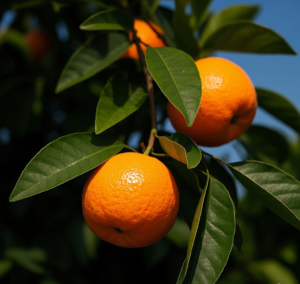Physical Address
304 North Cardinal St.
Dorchester Center, MA 02124
Physical Address
304 North Cardinal St.
Dorchester Center, MA 02124
When it comes to citrus fruits, the terms “tangerine” and “orange” are often used interchangeably, but they are not exactly the same. While both are members of the citrus family and share many similarities, there are distinct differences between tangerines and oranges. In this article, we’ll explore whether tangerine is the same as orange, their origins, characteristics, culinary uses, and nutritional benefits. Whether you’re a fruit enthusiast or a home cook, this guide will help you understand the nuances between these two popular citrus fruits.

A tangerine is a type of citrus fruit that belongs to the species Citrus tangerina. It is a variety of mandarin orange, which is a group of citrus fruits known for their loose, easily peeled skin and sweet, juicy flesh. Tangerines are smaller than oranges, with a round or slightly oval shape. Their skin is typically bright orange, and their flesh is divided into segments that are easy to separate.
Tangerines are known for their sweet, tangy flavor and aromatic scent. They are often enjoyed fresh, as a snack, or used in salads, desserts, and beverages. Tangerines are also a popular choice for children due to their small size and ease of peeling.
What is an Orange?
An orange is a citrus fruit that belongs to the species Citrus sinensis. It is one of the most widely cultivated and consumed citrus fruits in the world. Oranges are larger than tangerines and have a more rounded shape. Their skin is thicker and more tightly adhered to the flesh, making them slightly more difficult to peel than tangerines.
Oranges are known for their sweet-tart flavor and juicy flesh. They are commonly enjoyed fresh, squeezed into juice, or used in cooking and baking. Oranges are also a rich source of vitamin C, making them a popular choice for boosting immunity and overall health.
Is Tangerine the Same as Orange?
While tangerines and oranges are both citrus fruits and share many similarities, they are not the same. Here are the key differences between tangerines and oranges:
Types of Tangerines and Oranges
Both tangerines and oranges come in various varieties, each with its own unique characteristics.
Types of Tangerines:
Types of Oranges:
Culinary Uses of Tangerines and Oranges
Both tangerines and oranges are highly versatile in the kitchen. Here are some popular ways to use them:
Tangerines:
Oranges:
Nutritional Benefits of Tangerines and Oranges
Both tangerines and oranges are rich in essential nutrients and offer numerous health benefits.
Tangerines:
Oranges:
How to Choose and Store Tangerines and Oranges
When selecting tangerines and oranges, look for fruits that are firm, smooth, and free from blemishes. They should feel heavy for their size, indicating a high juice content.
Conclusion
In summary, tangerine is not the same as orange, though they are closely related and share many similarities. Tangerines are smaller, sweeter, and easier to peel, while oranges are larger, more acidic, and have a thicker skin. Both fruits are delicious and nutritious, with a wide range of culinary uses.
Whether you’re enjoying a juicy tangerine as a snack or squeezing fresh orange juice for breakfast, these citrus fruits are a delightful addition to any diet. So, the next time you’re at the grocery store, consider trying both tangerines and oranges to experience their unique flavors and benefits. Happy eating!